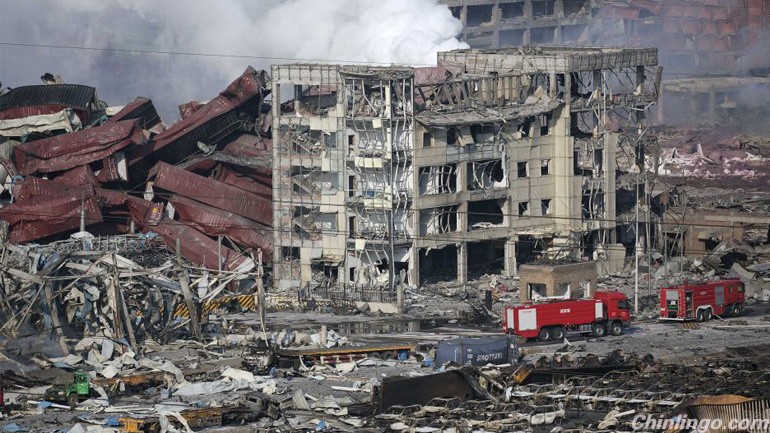
Ignoring the Warnings
无视警告
When local officials first recruited him as an adviser nearly a decade ago, Shao Chaofeng saw a chance to show that his ideas for energy-efficient and ecologically sound growth could find a home among the smokestacks and cranes of the Binhai economic zone.
近十年前,邵超峰首次被地方官员聘为顾问时,他认为这是一个机会:他在节能和生态平衡型增长方面的想法,可能会在滨海经济区的烟囱和起重机之间找到一席之地。
A young environmental engineer on the faculty at Nankai University in Tianjin, Professor Shao drafted dozens of papers setting out ideas for industrial development free of the haze, toxins and water pollution that have blighted much of eastern China.
当时他在天津南开大学任教,是一名年轻的环境工程师。他撰写了数十篇论文,阐述了自己对于无霾、无毒、无水污染的产业发展的一些想法。这些污染已经让中国东部很多地方陷入困境。
"Initially, people paid attention," he recalled.
"最开始有人注意,"他回忆说。
But if Professor Shao was at first inspired by the prospect of a "new Binhai," he finished his years of work on the district increasingly troubled. Officials were piling on one industrial project after another, sometimes dangerously close to schools and residential neighborhoods.
但是,如果说邵超峰最初是被"新滨海"的前景所鼓舞,那么在他此后开展工作的数年里,这里的状况却在日益恶化。官员们陆续上码了一个又一个工业项目,有些项目过度靠近学校和居民区。
As early as 2008, he and other academics in Tianjin warned in a paper of the strain on the environment, citing the risks posed by the chemical industry in particular. An accident or spill, they said, could devastate the region.
早在2008年,他和天津的其他学者就在一篇论文中对环境的压力提出了警告,特别谈到了化工行业带来的风险。他们说,如果发生事故或泄露,对该地区将是一场灾难。
Two years later, he and Sun Xiaorong, of the Tianjin Appraisal Center for Environment and Engineering, published another paper with models calculating that the risks of an accident in Binhai were growing and could peak in 2015.
两年后,他和天津市环境工程评估中心的孙晓蓉发表了另一篇论文,用模型计算出滨海发生事故的风险会不断增长,有可能在2015年达到峰值。
"The rapid development of industry, especially petroleum and chemical industries, have greatly increased major environmental risks in the Binhai New Area," they wrote. "But at the same time, environmental risk management standards in the district have not undergone timely and effective improvement."
"工业的快速发展,尤其是石油、化工行业的发展,使滨海新区的重大环境风险源大幅增加,"他们写道。"而与此同时,区域的环境风险管理水平并未得到及时、有效的提高。"
Officials were not hostile to his proposals, Professor Shao said, but many seemed overwhelmed by the pressure to build up the economic zone, and there were frequent reshuffles of personnel.
邵超峰说,官员对他的建议并没有持敌视态度,但建设经济区的压力似乎让很多人不堪重负,而且人事变动也相当频繁。
With huge oil refineries, ethane plants and other petrochemical projects, Binhai would quickly become China's largest chemical-industry park. Spurred by a national drive to build self-sufficiency in chemicals, the industry was growing at an annual rate of 10 percent and contributing as much as $600 billion to gross domestic product.
随着大型炼油厂、乙烷厂等石化项目的上马,滨海新区很快将成为中国最大的化学工业园区。国家的政策是在化学品上实现自给自足,在此政策刺激下,化工行业正在以10%的年增长率发展,对国内生产总值的贡献多达6000亿美元。
By about 2011, Professor Shao's government consultancy work on Binhai had dried up.
大约到2011年左右,邵教授在滨海新区的政府咨询工作就无从继续了。
But he continued raising alarms. In a paper in 2013, he and four co-authors warned that the risk of an accident related to the "storage and transportation" of chemicals in Binhai was increasing. They identified high-risk zones on color-coded maps, including one that highlighted the area housing Rui Hai and other facilities.
但他继续提出警告。在2013年的一篇论文中,他和其他四个共同作者警告说,在滨海"储运"化学品的事故风险正在增高。他们用不同颜色在地图上标出高风险区,其中一个突出的区域就是瑞海和其他设施的所在地。
Professor Shao and his co-authors were not alone. In a paper published late last year, a group of researchers at the Tianjin Marine Environment Monitoring and Forecasting Center issued a similar warning. "There have been constant incidents of pollution from the storage and transport of these chemicals, severely threatening the life, property and health of people in the area," they wrote.
邵超峰和合著者并不是唯一提出警告的人。在去年底发表的一篇论文中,天津市海洋环境监测预报中心的研究人员也发出了类似的警告。他们写道,"化学品在储存、运输过程中的污染事故也不断发生,严重威胁着区域人群生命财产健康安全。"
Based on incomplete statistics, they counted 84 instances of pollution at the port between 1998 and 2012, most of them attributed to "operational" failings. Yet, they noted, the government planned to develop the shipping of chemicals as a "main pillar" of the port's growth.
文中称,根据不完全统计,在1998年至2012年期间,天津港记录在案的污染事故共计84次,其中大部分是"操作性"事故。但他们指出,政府计划让化学品运输发展成为天津港经济增长的"重要支柱"。
Professor Shao was away on business when he heard the news of the explosions. Reached by telephone a few days later, he recalled feeling stricken by regret.
邵超峰得知爆炸消息时正在出差。几天之后接受电话采访时,他回忆了自己当时懊悔的心情。
"I felt deeply pained in my heart," he said. "I felt there were many things that could have been … " His voice petered off.
"我心里感觉很沉痛了,"他说。"有很多事情有可能提前可以……"他的声音渐渐低沉。
He said he and the others who built the risk model that forecast trouble in 2015 had never anticipated that a company would store such vast amounts of hazardous chemicals so close to a residential area.
他表示,他和其他人构建的风险模型预测2015年会出现问题。他们从未预料到一个距离居民区如此近的公司会储存这么多危险化学品。
"Such a large quantity of dangerous chemicals — it was just too much — should never have been placed in what was quite a central location," he said. "Even if it wasn't a residential district, even on the edge of the city, this was wrong."
"危化产品那么大的量 —— 那个量太大了—— 不应该在那样一个比较核心的地方,"他说。"即使不是有一个住宅区,在城区边上,那样的也不行。这么多危险化学品,太多了,不应该放在中心场所。"



 闽公网安备 35020302035673号
闽公网安备 35020302035673号
0 responses on "Secrets behind Tianjin explosion - part 3"